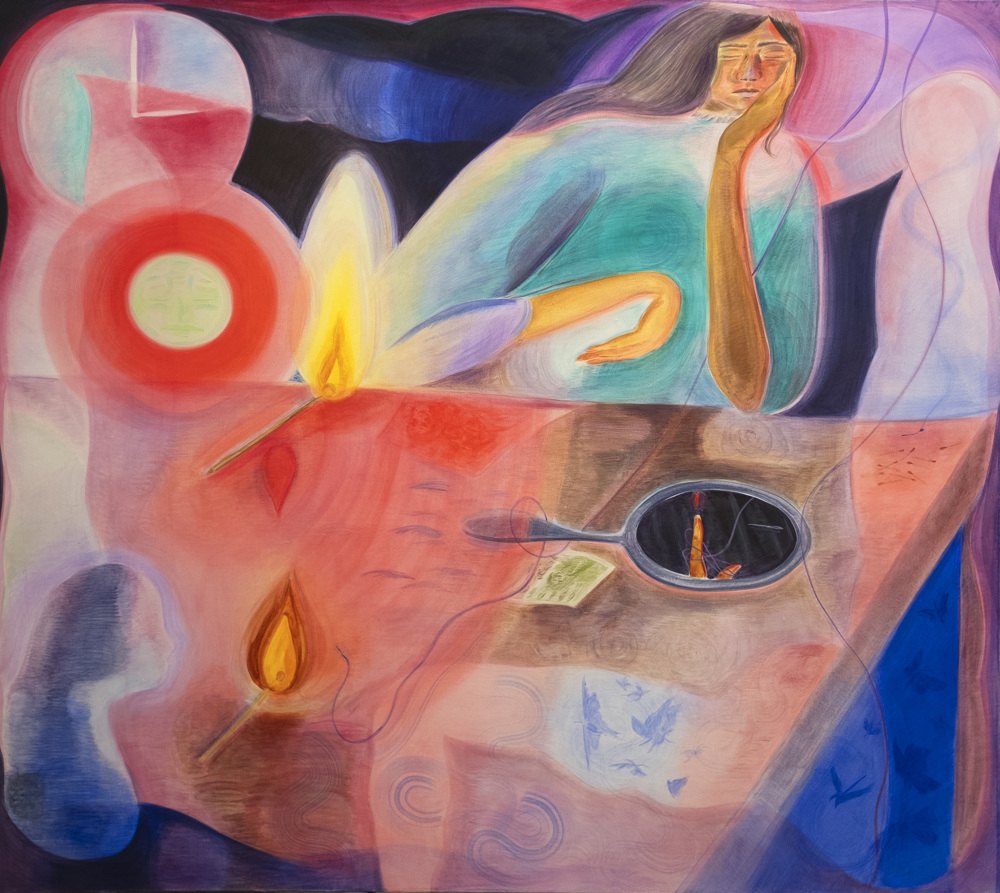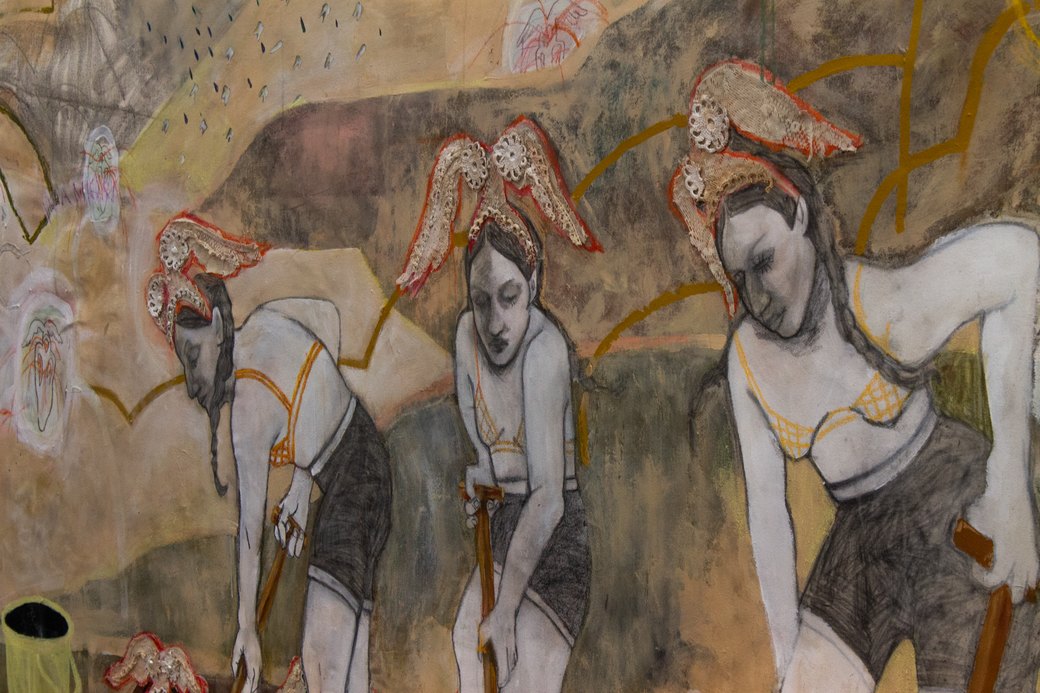Influence can make some painters anxious but, in a new show put on at the Selenas Mountain in Ridgewood, three painters turn unhesitatingly toward the last century’s modernist past, where the shadows of Dalí, Kahlo and Rivera dance glibly on the walls. The trio are three New York painters on the rise: all three hold BFAs from Pratt, Hunter, and School of the Museum of Fine Arts, Boston. One of the three, Larissa De Jesús Negrón, currently works at MoMa and had her first solo show at a gallery in Williamsburg last October. But the work from all three comes together to collectively use its excavated style to articulate the boundaries of a new world, a conversation with friends about war and capitalism.
The gallery, contained on the third floor of a refurbished warehouse near the tip of Woodward Avenue, has given this the set-up a more auspicious name: “These Opalescent Dreams of Mine,” a lovely phrase that ought to be hung up in the gallery as well. The butteriness of the words is perhaps most evocative of the work of Anjuli Rathod — the Tufts grad and who now lives in Queens. A painter interested in the possibilities of broad strokes, her best subject is the flame, which, in her hand, expands halo-like from the source. In her earlier work, Rathod focused on its more obvious appearances: in her 2019 painting “Burial,” the illuminated circles cast a curious pall that burns in the dark of the expected funeral; “Refraction,” from the same year, is less subtle and takes the idea to its obvious conclusions, which are strange, twisted and caustic. On display is some of her newer work and, of these, “Knots” (2021) is the show’s absolute blow-out. Lit matches hang as if suspended in mid air, but their light reveals a terrain of melancholy desperation and bitter solitude, anchored by a single mirror and surrounded by a dreamspace assemblage that includes fragments of string, a bust, a minimalist clock and the enormous table where the subject sits and thinks.


Rathod’s palette is airy and light, the color of dreams — the field of the unconscious, if the show’s name is to be believed. De Jesús Negrón, by contrast, goes for vivid and hard oils and stylizes postmodern takes on de Chirico-style dreamscapes. The winner here is the gently autobiographical “Larissa’s World” (2020), a factory of the imagination that turns out beer bottles floating appetizingly in a pool and the spaceship from Futurama lifting off from the ground. Such consumer products are a regular feature of her work — also in the show is the cleverly bent “Commuting with Scoliosis” which does glib, ironic wonders by centering its still life on a perplexing S’well bottle. Another work, hung off to the side in the gallery but highlighted as one of the show’s centerpieces is “Philosophical Meditation” (2020), a work the press materials indicate is named after “a practice used by psychologist and modern philosopher Alain de Botton.”
While not incredibly familiar with the work of the pop-philosopher behind such bestsellers as How Proust Can Change Your Life, there surely is some spiritual connection between these works and, oh, I dunno, Dalí’s paranoiac paintings and the necessary connections to Freud that I’m sure any art history textbook would go into detail on. Situated right next to “Larissa’s World,” however, is another piece of art-historical connective tissue, very literally so: “The Two Bravos” (2020) an elaborately framed mixed media piece by Pratt grad Amy Bravo presents a dueling self-portrait next to that of her own grandmother, an intensely-felt homage to Frida Kahlo’s famous 1939 painting “Two Fridas.” Where Kahlo wanted to depict the multiplicity of the self, Bravo depicts its literal origins and the work itself, which includes an immense plaster cast that holds the images up and colleges various personal effects, makes it feel strangely alive.

Bravo’s work brings the show back to earth, no less so than in her second piece on display, another immense recent work called “Vamos a Cosechar” (2021), in gallery where her subjects are seen literally digging into it. For Bravo, this is a sign of optimism — the diligence of working bodies brings to mind the work of Kahlo’s companion, the muralist Diego Rivera, who would no doubt see this as a part of the serene history of mass action. But what are they digging? Unlike Rivera, who plotted his working bodies inside the same recognizable city streets the murals were meant to look over, Bravo lets abstraction take over — the scene feels alien and the hard faces, drawn in tender graphite, carry a concern they cannot express. At a recent viewing, someone speculated that they were digging graves, but aren’t we all?
“These Opalescent Dreams of Mine” will be on display at the Selenas Mountain gallery at 63 Woodward Ave until March 28th. Socially-distant viewings are available by appointment at the gallery’s site.
Top: “Philosophical Meditation”(2020) by Larissa De Jesús Negrón.
For more news, sign up for Bushwick Daily’s newsletter.
Join the fight to save local journalism by becoming a paid subscriber.



